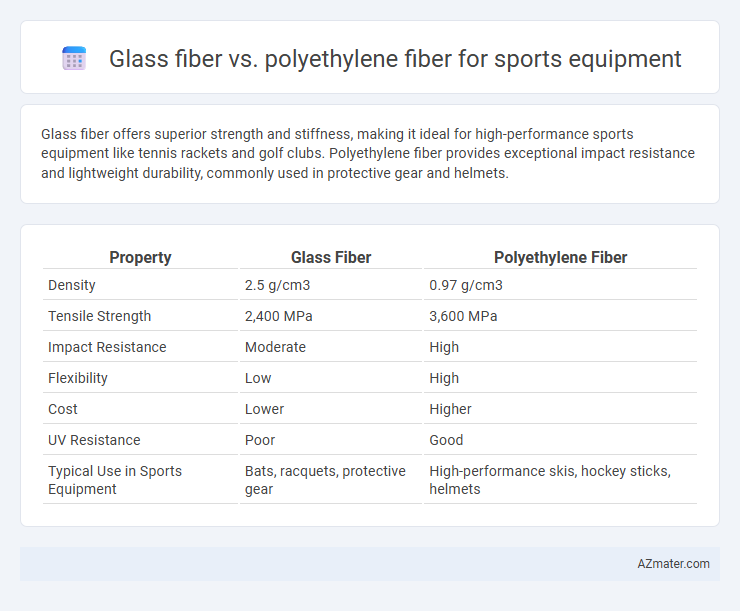Glass fiber offers superior strength and stiffness, making it ideal for high-performance sports equipment like tennis rackets and golf clubs. Polyethylene fiber provides exceptional impact resistance and lightweight durability, commonly used in protective gear and helmets.
Table of Comparison
| Property | Glass Fiber | Polyethylene Fiber |
|---|---|---|
| Density | 2.5 g/cm3 | 0.97 g/cm3 |
| Tensile Strength | 2,400 MPa | 3,600 MPa |
| Impact Resistance | Moderate | High |
| Flexibility | Low | High |
| Cost | Lower | Higher |
| UV Resistance | Poor | Good |
| Typical Use in Sports Equipment | Bats, racquets, protective gear | High-performance skis, hockey sticks, helmets |
Introduction: Comparing Glass Fiber and Polyethylene Fiber
Glass fiber offers high tensile strength and excellent stiffness, making it ideal for sports equipment requiring durability and impact resistance. Polyethylene fiber provides superior lightweight properties and outstanding flexibility, enhancing performance where agility and speed are critical. Comparing these fibers reveals trade-offs in weight, strength, and resilience that influence equipment design and athlete comfort.
Material Composition and Structure
Glass fiber consists primarily of fine strands of silica-based glass, offering high tensile strength and stiffness, making it ideal for sports equipment requiring durability and impact resistance. Polyethylene fiber, especially ultra-high-molecular-weight polyethylene (UHMWPE), is composed of tightly packed polymer chains that provide exceptional abrasion resistance, lightweight properties, and high energy absorption. The distinct material compositions lead glass fiber to excel in structural rigidity, while polyethylene fibers offer superior flexibility and lighter weight for enhanced athletic performance.
Mechanical Properties and Performance
Glass fiber offers superior tensile strength and stiffness compared to polyethylene fiber, making it ideal for sports equipment requiring high durability and rigidity, such as tennis rackets and hockey sticks. Polyethylene fiber, known for its excellent impact resistance, lightweight nature, and flexibility, excels in applications where shock absorption and agility are critical, like protective gear and lightweight helmets. The choice between glass fiber and polyethylene fiber significantly influences the mechanical performance, longevity, and user comfort in sports products.
Weight Considerations in Sports Equipment
Glass fiber offers a higher strength-to-weight ratio compared to traditional materials, but polyethylene fiber stands out for its ultra-lightweight properties, making it ideal for high-performance sports equipment where minimizing weight is critical. Polyethylene fibers such as Dyneema(r) or Spectra(r) deliver exceptional tensile strength with significantly lower density, reducing overall equipment weight without sacrificing durability. This weight advantage directly enhances athlete speed, agility, and endurance across sports like cycling, skiing, and racket sports.
Durability and Longevity
Glass fiber exhibits superior durability in sports equipment due to its high tensile strength and resistance to impact, making it ideal for items like tennis rackets and fishing rods. Polyethylene fiber offers exceptional longevity through its lightweight, moisture-resistant properties that prevent degradation over time, commonly used in protective gear and nets. Both materials enhance performance but glass fiber is preferable where rigid strength is critical, while polyethylene fiber excels in flexibility and environmental resistance.
Flexibility and Impact Resistance
Glass fiber offers high impact resistance and excellent rigidity, making it ideal for sports equipment requiring strength and durability, but it is less flexible compared to polyethylene fiber. Polyethylene fiber provides superior flexibility and shock absorption, enhancing comfort and performance in applications where movement and impact cushioning are critical. Choosing between the two depends on whether the priority is impact resistance and stiffness or flexibility and lightweight resilience.
Cost and Accessibility
Glass fiber offers a more affordable option compared to polyethylene fiber, making it a popular choice for budget-conscious sports equipment manufacturers. Polyethylene fiber, while more expensive, delivers superior strength-to-weight ratio and impact resistance, justifying its higher cost in premium gear. Accessibility to glass fiber is broader due to established manufacturing processes and widespread availability, whereas polyethylene fiber might require specialized suppliers, impacting lead times and overall accessibility.
Application Suitability in Various Sports
Glass fiber offers excellent rigidity and impact resistance, making it ideal for sports equipment such as hockey sticks, tennis rackets, and archery bows where stiffness and durability are crucial. Polyethylene fiber, known for its lightweight and high tensile strength, suits applications in protective gear like helmets, gloves, and lightweight body armor used in sports such as football and cycling. Each fiber's unique properties determine its suitability across diverse sports equipment, balancing factors like flexibility, strength, and weight for optimal performance.
Environmental Impact and Sustainability
Glass fiber offers high durability and strength but involves energy-intensive manufacturing with significant carbon emissions. Polyethylene fiber, especially ultra-high-molecular-weight polyethylene (UHMWPE), has a lower environmental footprint due to less energy use and recyclability potential. Both fibers' sustainability depends on lifecycle management, but polyethylene fibers generally present a more environmentally sustainable option for sports equipment.
Conclusion: Choosing the Right Fiber for Sports Equipment
Glass fiber offers superior strength and durability ideal for high-impact sports equipment, while polyethylene fiber provides exceptional lightweight properties and impact resistance suitable for agility-focused gear. Sports manufacturers should consider specific performance requirements such as tensile strength, flexibility, and weight when selecting between glass fiber and polyethylene fiber to optimize equipment performance. Ultimately, the optimal choice depends on balancing factors like durability, weight, and cost to enhance athlete performance and safety.

Infographic: Glass fiber vs Polyethylene fiber for Sports equipment
 azmater.com
azmater.com